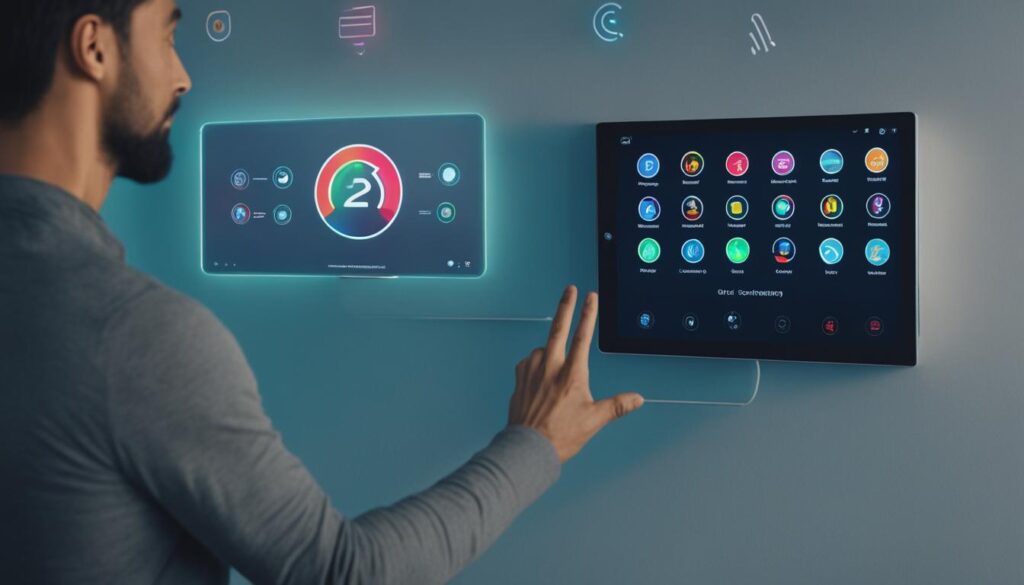As a beginner, entering the world of smart home systems can be both exciting and overwhelming. With so many options to choose from, it’s essential to select the right system that caters to your needs and preferences. Whether you’re looking to enhance convenience, increase security, or promote energy efficiency, finding the perfect smart home system is the first step towards creating a connected and automated home environment.
When it comes to choosing a beginner-friendly smart home system, there are several key factors to consider. Compatibility with existing devices is crucial to ensure seamless integration and maximum functionality. Additionally, ease of use and available features play a significant role in simplifying the transition to a smart home lifestyle. Of course, budget is a practical consideration, as you want a system that offers value for your money without compromising on quality and performance.
By taking the time to choose the right smart home system, you’ll be on your way to enjoying the convenience and automation that comes with a connected home. In the following sections, we will explore the benefits of smart home systems, discuss how to assess your needs and requirements, provide tips for researching different options, and guide you through the installation and customization process.
Table of Contents
Key Takeaways:
- Compatibility with existing devices is important in selecting a smart home system.
- Consider ease of use, available features, and budget when choosing a system.
- Smart home systems offer increased convenience, energy efficiency, and enhanced security.
- Assess your specific needs and requirements before making a decision.
- Research different options based on features, compatibility, customer reviews, and pricing.
Understanding the Benefits of Smart Home Systems
Smart home systems offer a range of benefits for beginners. By embracing this cutting-edge technology, you can enjoy a more convenient and efficient lifestyle. Let’s explore the advantages of smart home technology:
Increased Convenience
With a smart home system, you can effortlessly control your devices with a simple voice command or a tap on your smartphone. Whether it’s adjusting the temperature, turning off lights, or locking the doors, the convenience of automation saves you time and effort.
Energy Efficiency
Smart home technology allows you to optimize your energy consumption. By automating lights, thermostats, and appliances, you can ensure they are only used when needed, reducing wastage and lowering your energy bills.
Enhanced Security
Your safety is paramount, and smart home systems provide advanced security features. From video doorbells and surveillance cameras to smart locks and motion sensors, you can monitor and protect your home from anywhere, enhancing your peace of mind.
Remote Device Control
One of the greatest advantages of smart home systems is the ability to control your devices remotely. Whether you’re at work or on vacation, you can monitor and adjust your home settings through a smartphone app, ensuring you’re always in control.
By automating various aspects of your home and leveraging smart technologies, you can simplify your daily routines and enjoy a more comfortable and secure living environment.
With the rapid advancement of smart home technology, the benefits of embracing this futuristic lifestyle are undeniable. From increased convenience to energy savings and enhanced security, smart home systems offer a world of possibilities for beginners.
Assessing Your Smart Home Needs and Requirements
Before choosing a smart home system, it is essential to assess your specific needs and requirements. By understanding what you want to achieve with your smart home, you can make an informed decision that meets your expectations.
Begin by evaluating the areas of your home that you would like to automate. Consider whether you want to control the lighting, heating, or security systems through your smart home system. This will help you determine the necessary components and features required for your setup.
Next, consider how you prefer to control your smart home devices. Some systems require a central hub that acts as a control center for all connected devices, while others offer the convenience of controlling everything through a smartphone app. Think about your lifestyle and choose a system that aligns with your preferences.
Additionally, compatibility is crucial when assessing your smart home needs. Take into account any existing devices or platforms that you would like to integrate with your new system. Ensure that your chosen smart home system supports compatibility with these devices to avoid any complications or limitations.
Remember, assessing your smart home needs and requirements upfront will help you choose the right system that caters to your specific preferences and delivers the desired functionality.
Summary:
As you embark on your smart home journey, it’s important to assess your needs and requirements to select the optimal system. Evaluate the areas you want to automate, determine your preferred method of control, and ensure compatibility with your existing devices. By taking these steps, you can establish a solid foundation for building your smart home ecosystem.
Image:
Researching Smart Home System Options
When delving into the world of smart home systems, it’s important for beginners to conduct thorough research to find the perfect fit. By comparing different options, you can make an informed decision based on features, compatibility, customer reviews, and pricing.
Smart home systems offer a wide range of features and capabilities, making it crucial to understand what each system offers. Look for systems that provide a user-friendly interface, ensuring ease of use for both tech-savvy individuals and those new to smart home technology.
One strategy to ensure flexibility for future expansions is to choose a system with a wide range of compatible devices. This allows you to add new devices and integrate them seamlessly into your existing setup. Additionally, considering customer reviews can provide valuable insights into the user experience and overall satisfaction.
By researching and comparing smart home system options, beginners can find a system that aligns with their specific needs and preferences. Whether it’s controlling lighting, thermostats, or security features, a well-researched choice ensures a successful smart home integration.
Comparison Table: Features and Pricing
| Smart Home System | Features | Compatibility | Customer Reviews | Pricing |
|---|---|---|---|---|
| System A | Advanced automation, voice control | Compatible with major brands | 4.5/5 stars | $X |
| System B | Customizable routines, energy monitoring | Integrates with popular platforms | 4/5 stars | $Y |
| System C | Enhanced security features, video monitoring | Supports a wide range of devices | 3.5/5 stars | $Z |

Take your time exploring different smart home system options, and consider the features and pricing that best suit your needs. Remember, thorough research lays the foundation for a successful and enjoyable smart home experience.
Budgeting for a Smart Home System
When it comes to creating a smart home, setting a budget is a crucial step to ensure you don’t overspend. It’s important to consider both the initial cost of the smart home system and any additional devices or accessories that may be needed. Additionally, don’t forget to factor in ongoing costs such as subscriptions or maintenance fees. By having a clear budget in mind, you can narrow down your options and choose a system that aligns with your financial goals.
Let’s break down the different costs associated with a smart home system:
- Initial System Cost: This includes the cost of the main hub or controller, as well as any necessary installation expenses. Prices for smart home systems can vary widely depending on the brand, features, and level of automation. Research different options and compare prices to find the best fit for your budget.
- Additional Devices and Accessories: Beyond the main system, you may want to add extra devices such as smart thermostats, lighting controls, or security cameras. These devices come at an additional cost and should be considered in your budgeting process. Make a list of the devices you want to include and research their individual prices.
- Ongoing Costs: Some smart home systems require subscriptions or maintenance fees to access certain features or services. These costs can vary depending on the system and provider. Be sure to factor in any recurring expenses to accurately assess the long-term financial commitment of your smart home system.
Creating a budget not only helps you determine the overall cost of your smart home system, but it also keeps you financially grounded throughout the process. Remember, it’s essential to find the right balance between functionality and affordability.
Below is a sample budgeting template to help you get started:
| Expense | Estimated Cost |
|---|---|
| Main Smart Home System | $500 |
| Smart Thermostat | $200 |
| Security Cameras | $300 |
| Lighting Controls | $150 |
| Installation | $100 |
| Monthly Subscription | $10 |
| Total | $1,260 |
Keep in mind that this is just an example, and actual costs will vary depending on your specific needs and preferences. It’s important to personalize your budget and adjust it accordingly.
Now that you have a better understanding of budgeting for a smart home system, you can confidently move forward in your journey to create a more connected and automated living space.

Installing and Setting Up Your Smart Home System
Once you have selected a smart home system, it’s time to install and set it up. Follow the manufacturer’s instructions for installation, which may involve connecting devices, configuring settings, and setting up any necessary accounts or apps. Take the time to familiarize yourself with the system’s features and settings to make the most out of your smart home experience.
Installing and setting up a smart home system may seem overwhelming at first, but manufacturers provide comprehensive instructions to simplify the process. By following these steps, you’ll be on your way to transforming your home into a smart and connected space.
Step 1: Gather Your Equipment
Before you begin the installation process, gather all the necessary equipment required for your smart home system, including devices, cables, and any additional components. Make sure you have everything you need before proceeding.
Step 2: Read the Instructions
Read the manufacturer’s instructions thoroughly before starting the installation process. Pay attention to any specific requirements or recommendations mentioned in the manual. This will ensure a smooth and successful installation.
Step 3: Connect Devices
Begin by connecting the devices included in your smart home system. This may involve plugging in smart speakers, connecting smart light bulbs or switches, and linking security cameras. Refer to the instructions for each device to correctly establish the connections.
Step 4: Configure Settings
After connecting the devices, it’s time to configure the settings. This may include connecting to your home Wi-Fi network, creating user accounts, and customizing preferences. Follow the instructions provided by the manufacturer for each device to ensure proper setup.
Step 5: Set Up Apps and Accounts
Many smart home systems require the use of dedicated apps to control and monitor devices. Install the necessary apps on your smartphone or tablet and create user accounts as directed. This will provide you with access to all the features and functionalities of your smart home system.
Step 6: Test and Troubleshoot
Once the devices are connected, settings are configured, and apps are set up, take the time to test the functionality of your smart home system. Ensure that all devices respond to commands and perform as expected. If you encounter any issues, consult the troubleshooting section of the manual or reach out to customer support for assistance.
“Installing a smart home system is a transformative step towards a more convenient and efficient living space. Take your time during the installation process, and don’t hesitate to seek help if needed.”
Step 7: Explore and Experiment
Now that your smart home system is installed and set up, it’s time to explore its features and experiment with different automation routines. Discover the convenience of controlling your lights, adjusting your thermostat, or securing your home with just a few taps on your smartphone or a voice command to your smart speaker. Unlock the full potential of your smart home system by discovering new integrations and customizing it to suit your needs.
Expanding and Customizing Your Smart Home System
As beginners become more comfortable with their smart home system, they may choose to expand and customize it further. The flexibility and versatility of smart home technology allow users to tailor their setup according to their preferences and needs. By adding new devices, integrating additional services or platforms, and creating custom automation routines, users can enhance their smart home experience and make their daily lives even more efficient and convenient.
Adding New Devices
One way to expand your smart home system is by adding new devices that complement your existing setup. Whether it’s smart lights, thermostats, door locks, or security cameras, there is a wide range of devices available on the market. Consider your specific needs and choose devices that integrate seamlessly with your current system. For example, if you have a smart hub, ensure that the new devices are compatible with it to ensure smooth operation and control.
Integrating Additional Services or Platforms
To further customize your smart home system, you can integrate additional services or platforms. For example, if you enjoy streaming music, you can connect your smart speakers to popular music streaming services such as Spotify or Apple Music. If you appreciate home automation, you can integrate your smart home system with virtual assistants like Amazon Echo or Google Home, allowing you to control your devices through voice commands. The possibilities are vast, and by exploring different integrations, you can truly personalize your smart home experience.
Creating Custom Automation Routines
Customization is a key aspect of a smart home system. Take advantage of the automation capabilities to create custom routines that suit your lifestyle. For example, you can set up an “Away” routine that turns off all the lights, lowers the blinds, and adjusts the temperature when you leave the house. Or, you can create a “Good Morning” routine that gradually increases the lighting, starts playing your favorite music, and prepares your coffee. The ability to customize automation routines allows you to tailor your smart home to your unique preferences and daily routines.
“Expanding and customizing your smart home system is an ongoing process that allows you to adapt your setup to your changing needs and preferences.”
Remember to keep an eye out for new compatible devices and features in the market. Manufacturers are continually releasing innovative products and software updates that can enhance your smart home system. Staying informed about the latest advancements ensures that you can take full advantage of the expanding ecosystem of smart home technology.
| Benefits of Expanding and Customizing Your Smart Home System |
|---|
| 1. Enhanced control and flexibility |
| 2. Increased efficiency and convenience |
| 3. Personalized experiences tailored to your needs |
| 4. Integration with other smart devices and platforms |
Conclusion
Summing up the process of choosing a smart home system as a beginner, it has been an exciting and fulfilling journey. By carefully considering your needs, researching available options, and setting a realistic budget, you can find a smart home system that perfectly aligns with your requirements.
During the selection process, remember to:
1. Assess your specific needs and determine the areas of your home you want to automate.
2. Research different smart home systems, comparing their features, compatibility, customer reviews, and pricing.
3. Set a budget that encompasses both the initial cost and any ongoing expenses, such as subscriptions or maintenance fees.
Once you have chosen your smart home system, the next step is to properly install and set it up. Follow the manufacturer’s instructions and familiarize yourself with the system’s features and settings to make the most out of your smart home experience. Over time, be open to expanding and customizing your system as your needs evolve.
By choosing the right smart home system, you can transform your living space into a tech-friendly and convenient environment that enhances your lifestyle. Embrace the possibilities that a smart home has to offer and enjoy the convenience, automation, and peace of mind that comes with it.
FAQ
What factors should I consider when selecting a smart home system as a beginner?
When choosing a smart home system as a beginner, it’s important to consider factors such as compatibility with existing devices, ease of use, available features, and your budget.
What are the benefits of smart home systems for beginners?
Smart home systems offer benefits such as increased convenience, energy efficiency, enhanced security, and the ability to control devices remotely.
How do I assess my smart home needs and requirements?
To assess your smart home needs, consider the areas of your home you want to automate, such as lighting, heating, or security. Determine if you prefer a system with a central hub or one that can be controlled through a smartphone app. Also, consider compatibility requirements with existing devices or platforms.
How do I research smart home system options?
To research smart home system options, compare different systems based on their features, compatibility, customer reviews, and pricing. Look for systems with user-friendly interfaces and a wide range of compatible devices for flexibility.
How should I budget for a smart home system?
When budgeting for a smart home system, consider the initial cost of the system, additional devices or accessories required, and any ongoing costs such as subscriptions or maintenance fees.
How do I install and set up my smart home system?
Follow the manufacturer’s instructions for installation, which may involve connecting devices, configuring settings, and setting up any necessary accounts or apps. Take the time to familiarize yourself with the system’s features and settings.
How can I expand and customize my smart home system?
As you become more comfortable with your smart home system, you can expand and customize it by adding new devices, integrating additional services or platforms, and creating custom automation routines.
What is the conclusion to choosing a smart home system as a beginner?
By considering your needs, researching options, setting a budget, and properly installing and setting up your smart home system, you can create a tech-friendly and convenient living space that enhances your lifestyle.
Source Links
- https://www.amazon.com/gcx/Premium-Kitchen-&-Dining/gfhz/events?_encoding=UTF8&canBeEGifted=false&canBeGiftWrapped=false&categoryId=HMT-PM-kitchen&getItByToday=false&getItByTomorrow=false&isLimitedTimeOffer=false&isPrime=false&pd_rd_w=G1Oab&content-id=amzn1.sym.a3cc80a8-d1c9-4dbe-ab1b-3941947f282e&pf_rd_p=a3cc80a8-d1c9-4dbe-ab1b-3941947f282e&pf_rd_r=JBYM1E0PVFNYGWVGFKHY&pd_rd_wg=jo9qZ&pd_rd_r=a2d98604-5f5c-483e-8a29-a6eae98be1a0&ref_=pd_gw_unk
- https://www.amazon.com/gcx/Premium-Kitchen-&-Dining/gfhz/events?_encoding=UTF8&canBeEGifted=false&canBeGiftWrapped=false&categoryId=HMT-PM-kitchen&getItByToday=false&getItByTomorrow=false&isLimitedTimeOffer=false&isPrime=false&scrollState=eyJpdGVtSW5kZXgiOjAsInNjcm9sbE9mZnNldCI6NjkyLjExNjY5OTIxODc1fQ==§ionManagerState=eyJzZWN0aW9uVHlwZUVuZEluZGV4Ijp7ImFtYWJvdCI6MH19&subcategoryIds=HMT-PM-kitchen:appliances&pd_rd_w=R5Ujl&content-id=amzn1.sym.a3cc80a8-d1c9-4dbe-ab1b-3941947f282e&pf_rd_p=a3cc80a8-d1c9-4dbe-ab1b-3941947f282e&pf_rd_r=GRBCVMA1MWKS4J6QC8R0&pd_rd_wg=wEDkb&pd_rd_r=3fea8e97-5803-4f06-8323-fc2cd6f522db&ref_=pd_gw_unk
- https://robots.net/computing-and-gadgets/smart-home-gadgets/how-to-wire-a-3-1-speaker-system-to-an-av-receiver/


